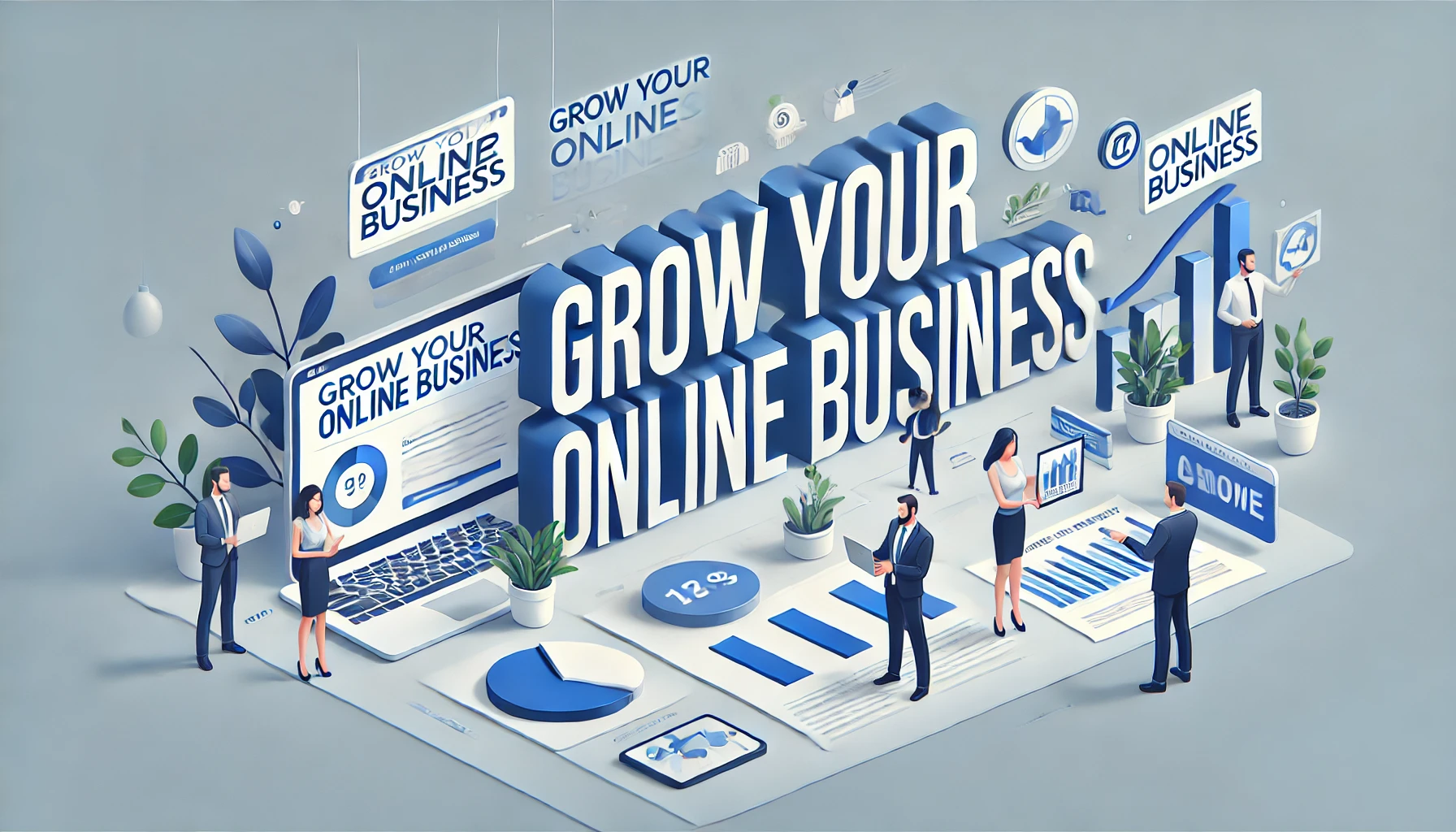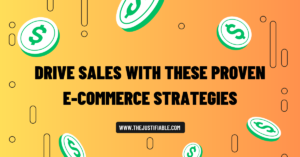Table of Contents
Are you eager to grow your online business and achieve rapid results? Wondering which strategies can offer the biggest impact? This guide will walk you through proven, actionable steps to boost your online business growth.
Build A Strong Online Presence For Fast Growth

Creating a strong online presence is essential if you want to grow your online business quickly. A well-optimized online presence attracts potential customers and builds trust with your audience, setting the foundation for sustained growth and engagement.
Optimize Your Website For Maximum Visibility
Your website acts as the digital storefront of your online business, making optimization crucial. I suggest focusing on aspects like mobile responsiveness, quick loading times, and effective navigation to make the site user-friendly and search engine-friendly.
Effective website optimization involves using relevant keywords in page titles, meta descriptions, and headings. When you optimize naturally, you’ll create a website that’s more likely to rank higher in search engine results, bringing more traffic to your business over time.
Another essential part of website optimization is minimizing errors and broken links. Such issues disrupt user experience and negatively impact SEO, so keeping your site updated is a must. I recommend using tools like Sitechecker to monitor and address any errors quickly.
Lastly, consider your website’s design and layout. A clean, visually appealing design encourages visitors to stay longer, which can reduce bounce rates. A site that’s easy on the eyes and simple to navigate is more likely to make a lasting impression.
Enhance User Experience To Retain Visitors
The user experience is at the heart of every successful website. I believe an intuitive, engaging user experience keeps visitors on your site longer and leads to better conversions. Small tweaks, like optimizing images or adjusting color schemes, can make a big difference.
User-friendly websites provide clear and easy access to essential information. Visitors appreciate straightforward navigation, so ensuring that your main pages and services are easy to find can make a significant impact. Focus on clarity to help visitors navigate without frustration.
Quick-loading pages play a crucial role in retaining visitors. No one likes to wait for a slow page, so I recommend using tools like Google PageSpeed Insights to ensure your site performs optimally. This is especially important for mobile users.
Visual appeal enhances user experience too. High-quality images, videos, and an uncluttered layout help keep users engaged. I advise investing in good visuals that align with your brand; they add a professional touch and make your content more appealing.
Create Compelling Branding That Resonates
Your brand speaks for your business, so creating a memorable, consistent brand identity is essential. Branding reflects your business’s values, helping you build a deeper connection with your audience and instilling trust. A strong brand can make your business unforgettable.
Branding elements like logos, colors, and fonts should be consistent across platforms. This consistency establishes trust and makes your business easily recognizable. I suggest selecting brand elements that resonate with your target audience to foster familiarity.
Clear, concise messaging is key to effective branding. I recommend crafting a unique value proposition that highlights what sets your business apart. Your messaging should communicate the benefits you offer in a way that speaks directly to your ideal customers.
Positive associations with your brand create loyalty. Engaging with your audience authentically on social media, email, and other channels strengthens these associations. Building this rapport with potential customers can encourage them to choose you over competitors.
Leverage Social Media To Expand Reach
Social media platforms are invaluable for growing your online business fast. They provide a direct connection with your audience, allowing you to reach a broader audience and foster engagement. I suggest identifying the platforms where your target customers spend time.
Sharing high-quality content on social media attracts followers and encourages interaction. Consistency in posting helps keep your audience engaged. Using a variety of content—like images, videos, and infographics—keeps your page interesting and encourages followers to stay engaged.
Social media advertising allows for precise targeting based on demographics, interests, and behaviors. Investing in ads can increase brand visibility and drive traffic to your website, so I recommend testing small ad campaigns to see what works best for your business.
Engaging directly with followers helps build a community around your brand. Responding to comments, hosting live Q&As, or sharing user-generated content makes followers feel valued. This kind of connection can turn casual followers into loyal customers.
Use SEO To Grow Your Online Business Fast
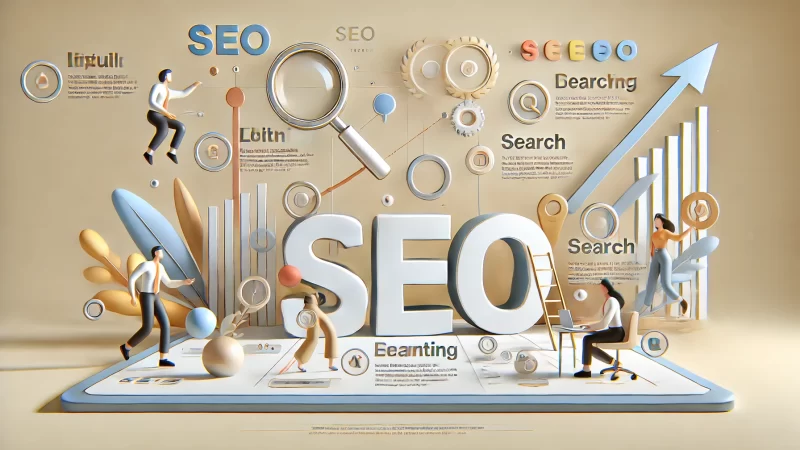
SEO is the backbone of online visibility and growth, providing a solid foundation to attract organic traffic. I advise focusing on effective SEO strategies that improve your search rankings, boost credibility, and bring in a steady stream of potential customers.
Choose High-Impact Keywords For Better Ranking
Keywords are essential to SEO success. High-impact keywords connect your content with what people are searching for, so I suggest researching phrases that your audience frequently uses and integrating them naturally throughout your content for a better ranking.
Long-tail keywords can boost visibility, especially in niche areas. These phrases have less competition and often align closely with user intent, helping you rank higher for specific searches. I recommend targeting both high-volume and long-tail keywords to balance visibility and relevance.
Keyword research tools can help identify terms with strong potential. Tools like Ahrefs, SEOPowersuite, and Semrush reveal which keywords bring the best results. Investing in these tools can give you a significant edge in your SEO efforts.
Keyword placement matters too. Including keywords in strategic places like titles, meta descriptions, and the beginning of paragraphs improves search engines’ ability to recognize and rank your content. Effective placement without overuse is key to natural, engaging content.
Focus On On-Page And Technical SEO Basics
On-page and technical SEO lay the foundation for search visibility. They ensure that your website meets search engines’ quality standards, making it easier to rank. I suggest paying close attention to titles, meta tags, and internal linking for on-page optimization.
Technical SEO involves factors like site speed, mobile-friendliness, and secure connections (HTTPS). These elements contribute to a smooth user experience, and search engines favor sites that perform well technically. Regularly auditing your site can help maintain high standards.
Internal links improve website navigation and keep visitors on your site longer. They help connect related content, making it easier for visitors to find what they need. This boosts engagement and signals to search engines that your site provides valuable information.
Optimized images and media enhance on-page SEO. Large files can slow down your site, so compressing images and using descriptive alt text keeps your website efficient and accessible to all users, including those with disabilities.
Build Quality Backlinks To Improve Authority
Backlinks from reputable sites increase your authority in search engines’ eyes. Quality backlinks signal to search engines that your site is credible and valuable. I suggest reaching out to relevant blogs or publications in your niche to gain links from established sites.
Guest blogging offers an effective way to earn backlinks. Writing valuable content for high-authority sites can drive traffic back to your business while enhancing your site’s reputation. I recommend pitching guest posts to blogs that align with your niche.
Social shares can lead to natural backlinks. When people share your content, it reaches new audiences who might link to it on their websites or social profiles. Creating shareable content increases your chances of earning these valuable backlinks.
Building relationships with industry influencers can also lead to backlinks. Networking with people who have an established online presence opens opportunities for collaboration and link-building. These relationships are often mutually beneficial and help build your authority.
Utilize Local SEO To Capture Regional Markets
Local SEO helps attract customers within specific geographic areas. I recommend claiming your Google My Business listing to enhance local visibility. This simple step makes it easier for nearby customers to find your business, especially on mobile.
Incorporate location-based keywords in your content and metadata. Using terms relevant to your area helps you rank better for local searches. This strategy works particularly well for businesses that serve specific regions or have a physical presence.
Local citations strengthen your local SEO efforts. Listings on directories like Yelp, TripAdvisor, and industry-specific sites improve your credibility and visibility. Consistent business information across these sites can improve your local rankings significantly.
Encouraging customer reviews boosts local SEO. Positive reviews on platforms like Google or Yelp contribute to your business’s online reputation and help with search rankings. I suggest encouraging satisfied customers to leave reviews for additional exposure.
Leverage Content Marketing For Rapid Business Growth

Content marketing is a powerful strategy to grow your online business quickly. When you create valuable, relevant content, it attracts leads, builds trust, and encourages long-term relationships, giving your business the foundation for sustainable, rapid growth.
Publish High-Value Content That Attracts Leads
High-value content is key to attracting the right audience. I suggest focusing on creating content that directly addresses the needs of your target customers. This way, your content resonates and serves as a solution, positioning you as an expert.
Content that solves specific problems naturally attracts leads. Guides, tutorials, and educational posts can be highly effective. When potential customers see the practical value you offer, they’re more likely to engage with your business and explore further.
To maintain high-value content, focus on in-depth, well-researched topics. I recommend exploring each subject thoroughly to provide genuine insights that are hard to find elsewhere. This approach boosts credibility and keeps readers coming back.
Sharing actionable advice in your content adds even more value. Readers appreciate clear steps they can follow, and this positions your brand as a helpful resource. Practical, high-value content is a magnet for potential leads.
Use Blog Posts To Educate And Engage Readers
Blog posts offer an ideal way to educate and engage. Each post can dive into specific topics your audience cares about. I advise using an informal tone, making complex topics easy to understand, and encouraging readers to keep learning.
Educational blog posts attract curious, motivated readers who may become loyal customers. Write about industry trends, best practices, and common questions your audience has. Answering these questions effectively builds trust and credibility.
Regularly publishing blog content signals to search engines that your site is active, improving SEO. I suggest creating a content calendar to stay consistent. Fresh content helps attract organic traffic, which grows your online business over time.
Interacting with readers through blog comments enhances engagement. Responding to questions or feedback shows your audience that you value their input. Engaging with readers directly builds community and makes your brand more relatable.
Create Visual Content For Increased Engagement
Visual content captures attention and improves engagement. I believe incorporating images, infographics, and videos enhances content and keeps visitors interested. This type of content is also highly shareable, helping you reach a wider audience.
Visuals make information easier to digest. Infographics are particularly effective for presenting complex data in an easy-to-understand format. They can also be shared widely, giving your business a chance to reach more potential customers.
Videos add a dynamic layer to content. Product demonstrations, tutorials, and behind-the-scenes videos give audiences an authentic look into your business. I suggest exploring video content to provide value and showcase your brand’s personality.
Using high-quality images creates a professional impression. Low-quality visuals can detract from your content’s credibility, so I recommend investing in professional images or using quality stock images to enhance your brand’s visual appeal.
Develop A Consistent Content Schedule
A consistent content schedule keeps your audience engaged and coming back. Regular posts show readers you’re active and committed, which builds trust. I suggest planning a schedule that balances quality with frequency for a sustainable approach.
Consistency helps with SEO too. When you post regularly, search engines recognize your site as a relevant, authoritative source. I recommend setting specific days for publishing to build an audience who knows when to expect new content.
A content calendar can help keep you organized. Planning topics and publishing dates in advance ensures you stay on track. This structure also allows you to explore different content types, adding variety to engage a broader audience.
Scheduling content lets you test what resonates best. I suggest paying attention to which posts attract the most engagement. This insight can guide future content, helping you focus on what truly adds value to your audience.
Maximize Conversions Through Effective Sales Funnels
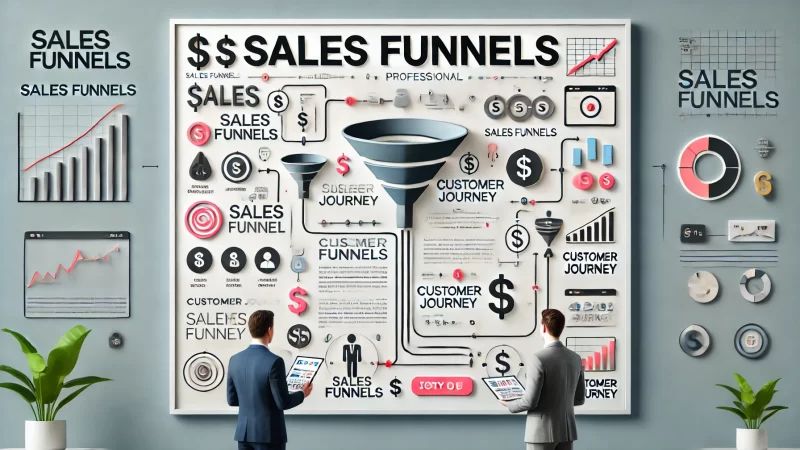
Effective sales funnels guide potential customers from interest to purchase. When structured well, they make it easier for visitors to understand your offerings and build the trust necessary to convert, ultimately helping you grow your online business.
Design A Clear, Optimized Sales Funnel Process
A clear sales funnel guides visitors smoothly through each step. I recommend starting with an awareness phase that introduces your brand, followed by stages that build interest, desire, and finally, motivate users to take action.
Each stage of the funnel should address specific customer needs. For example, the awareness stage can feature educational content, while the desire stage might include testimonials or product demos. This approach keeps potential customers engaged.
Clear calls-to-action (CTAs) are essential. Guide users toward the next step with well-placed CTAs that communicate value. I advise using language that’s friendly but persuasive, encouraging visitors to take that next step toward conversion.
Testing and refining each funnel stage improves results. Small adjustments, like changing CTA wording or adding testimonials, can make a big difference. Tracking each stage helps you see where people drop off and make targeted improvements.
Use Lead Magnets To Capture Prospective Clients
Lead magnets attract potential customers by offering value upfront. Ebooks, guides, or discount codes can entice visitors to share contact information. I recommend offering lead magnets that address common needs or challenges your audience faces.
Effective lead magnets should be relevant and practical. For instance, if your audience seeks marketing tips, a downloadable checklist can offer instant value. Providing actionable resources shows you understand their needs and builds initial trust.
Once you capture leads, nurture them with follow-up content. I suggest sending welcome emails or exclusive content to new leads, making them feel valued. This helps create a positive first impression and encourages them to stay engaged.
Personalizing lead magnet offers can also increase conversions. I advise segmenting your audience based on interests to deliver targeted offers. This personalized approach makes prospects more likely to engage and become long-term customers.
Implement Retargeting Ads To Boost Conversions
Retargeting ads reach visitors who’ve shown interest but didn’t convert. They serve as a reminder, drawing users back to your site. I recommend using retargeting strategically to re-engage potential customers who are already familiar with your brand.
Retargeting can highlight specific products or services. Tailor these ads to users’ past behavior, showing them items they viewed or related options. This personalized touch increases the likelihood they’ll return and make a purchase.
Frequency matters with retargeting. Too many ads can overwhelm, while too few might be ineffective. I suggest testing different frequencies to find the sweet spot that keeps your brand visible without seeming intrusive.
Using time-sensitive offers in retargeting ads can encourage action. A discount or limited-time promotion adds urgency, motivating users to take action sooner. This strategy works well to recapture attention and boost conversions.
Test And Refine Your Funnel For Improved Results
Testing each part of your sales funnel helps optimize conversions. I believe regular testing lets you spot areas for improvement, whether it’s adjusting messaging or redesigning pages to better guide users toward a purchase.
Split-testing is particularly effective. Trying out different versions of CTAs, layouts, or images reveals what resonates most. This data-driven approach helps you make informed decisions to improve each stage of your funnel.
Track key metrics like conversion rates and click-through rates. I suggest using tools like Google Analytics to monitor how users move through the funnel. This insight guides your tweaks and helps you measure the impact of changes.
Feedback from customers can highlight funnel pain points. Gathering insights from surveys or customer service interactions shows where users face friction. Addressing these issues makes the funnel experience smoother and more user-friendly.
Engage Customers Using Personalized Email Marketing
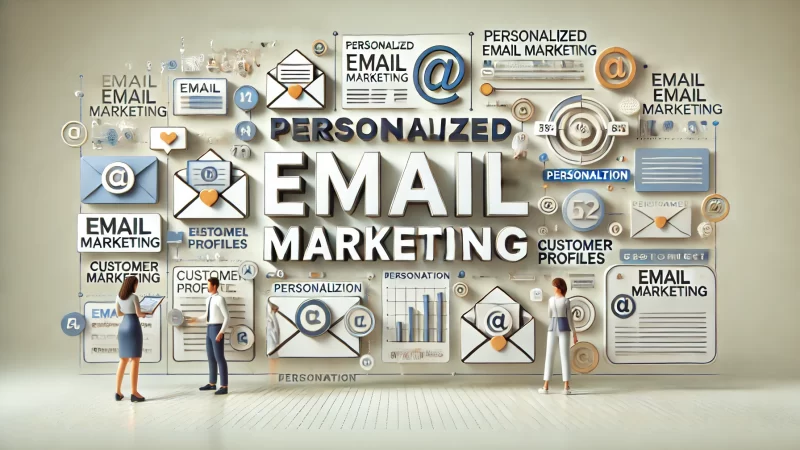
Email marketing creates a direct line to your customers, letting you build relationships and foster loyalty. Personalized emails can keep your brand top of mind, driving engagement and helping to grow your online business steadily.
Build And Segment Your Email List Effectively
A segmented email list lets you tailor messages to specific audiences. I advise building your list by offering value—such as exclusive content or discounts—that encourages visitors to sign up, ensuring they’re genuinely interested in your business.
Segmentation helps deliver relevant content. Divide your list based on factors like interests, past purchases, or engagement levels. This targeted approach keeps readers engaged and makes them more likely to act on your emails.
Quality over quantity is key in list-building. I recommend focusing on engaged subscribers rather than numbers alone. A smaller, engaged list outperforms a large, inactive one, resulting in better open rates and conversions.
Regularly updating and cleaning your list maintains quality. Remove inactive subscribers to improve engagement metrics. This practice keeps your email strategy efficient and focused on readers who genuinely care about your content.
Create Tailored Email Campaigns That Convert
Tailored email campaigns boost conversions by speaking directly to readers’ needs. Crafting personalized messages for different segments makes recipients feel valued. I recommend addressing specific needs to show customers you understand them.
Product recommendations based on past behavior personalize the experience. Suggest items similar to previous purchases, or share new arrivals that match their interests. This type of personalization encourages recipients to revisit your site.
Limited-time offers can create urgency. Time-sensitive discounts or promotions motivate readers to act fast, driving higher conversion rates. Including a clear CTA that emphasizes the offer adds a sense of urgency and encourages immediate action.
Following up on abandoned carts can capture lost sales. A gentle reminder about the items left behind, possibly with a discount, can win back potential customers. This strategy often proves effective in boosting sales from nearly-completed transactions.
Automate Follow-Up Emails To Enhance Engagement
Automating follow-up emails helps maintain contact with subscribers without overwhelming your workload. Automated emails can nurture relationships by consistently providing valuable information, keeping your brand top of mind for potential customers.
Automated sequences ensure timely communication. I suggest setting up triggers based on user actions—like a welcome series for new sign-ups or reminders for abandoned carts. This approach keeps engagement high with minimal manual effort.
Personalized follow-ups build trust. When emails feel tailored to each recipient, they’re more likely to engage. I recommend using segmentation to deliver specific content based on subscribers’ actions, enhancing relevance and appeal.
Automation also enables efficient lead nurturing. Set up drip campaigns that guide users through your funnel over time. This strategy helps build connections while gradually moving subscribers closer to making a purchase decision.
Use Analytics To Measure And Improve Performance
Analytics offer insight into how email campaigns perform, showing what’s working and what isn’t. I suggest using email analytics tools to track metrics like open rates, click-through rates, and conversions, helping you optimize each campaign.
Regularly review key metrics to spot trends. High open rates suggest strong subject lines, while low click-throughs may indicate the need for better CTAs. These insights help you refine your emails to improve results over time.
Experiment with A/B testing to optimize performance. Testing elements like subject lines, email layouts, or CTAs reveals what resonates best with your audience. I advise testing one change at a time to see clear, actionable results.
Use customer feedback to adjust strategies. Surveying your subscribers for input on what they enjoy or want more of adds a valuable perspective. Combining direct feedback with data helps you create email campaigns that genuinely connect with readers.
Drive Sales Through Influencer And Affiliate Marketing
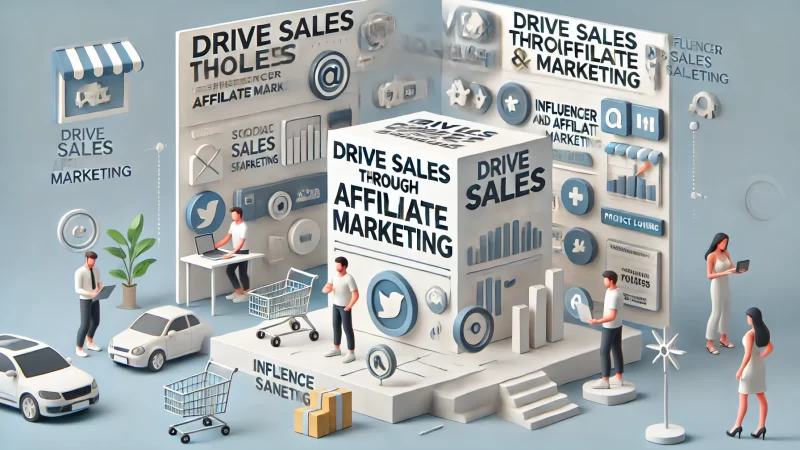
Influencer and affiliate marketing are effective ways to grow your online business by reaching wider audiences. When you work with trusted partners, they promote your brand to their followers, driving traffic and increasing sales conversions.
Partner With Influencers To Expand Audience
Influencer partnerships connect your brand with a larger audience. I suggest working with influencers who align with your values and target market. This approach brings credibility to your brand and introduces you to potential customers authentically.
Influencers provide access to a community that trusts their recommendations. I recommend evaluating an influencer’s engagement rate rather than just their follower count. High engagement often means their followers are more likely to interact with your brand.
Collaborating on content creates valuable exposure. Consider influencer-led campaigns like product reviews, tutorials, or live Q&As. These strategies give followers an in-depth view of your products and can drive interest effectively.
Genuine partnerships build long-term trust. I suggest choosing influencers who genuinely like your products, as their enthusiasm will feel authentic to their followers. This honest approach increases the likelihood of meaningful engagement and conversions.
Utilize Affiliate Programs To Boost Sales
Affiliate marketing is a great strategy for driving sales and expanding reach. By creating a commission-based affiliate program, you encourage partners to promote your products, allowing you to reach new customers without upfront costs.
Affiliate partners have a direct incentive to promote. I recommend offering a competitive commission structure to attract quality affiliates who will actively promote your business. This setup aligns their success with yours, benefiting both parties.
Tracking links are essential in affiliate programs. These links help measure each affiliate’s impact, letting you know which partners drive the most sales. I advise using affiliate platforms that simplify tracking and provide insights on partner performance.
Regular communication keeps affiliates engaged. Sharing updates, promotional ideas, or exclusive discounts gives affiliates more reason to stay active. Building a supportive relationship helps affiliates feel valued and motivated to perform well.
Track And Analyze Results For Optimal ROI
Tracking and analyzing influencer and affiliate campaigns are vital to maximize ROI. Monitor each campaign to understand which strategies work best and adjust as needed. I recommend setting specific goals for each campaign, like sales or clicks.
Analytics tools help gauge the success of influencer and affiliate efforts. Using tools like Voluum or affiliate dashboards provides insights into clicks, conversions, and revenue. This data-driven approach helps refine your future strategies.
Conversion rates reveal each campaign’s effectiveness. High engagement without conversions might indicate the need for adjustments. I suggest experimenting with different messages or incentives to see what resonates most with audiences.
Adjusting campaigns based on results boosts long-term effectiveness. I advise making incremental changes rather than large-scale shifts. Small tweaks can optimize performance without disrupting your ongoing partnerships and relationships.
Optimize Partnerships Based On Performance
Optimizing influencer and affiliate partnerships enhances overall marketing effectiveness. I believe it’s helpful to assess each partner’s impact, focusing on those who bring consistent results. This strategy allows you to invest in partnerships that truly drive growth.
Identifying top-performing partners lets you strengthen valuable relationships. Offering higher commissions or exclusive opportunities to these partners encourages continued collaboration. This approach rewards loyal affiliates and keeps them motivated.
Regular evaluations help refine your partnerships. Analyzing performance quarterly or biannually provides a clear picture of what’s working. I suggest using this data to make strategic decisions on which partnerships to scale.
Experimenting with new partners can uncover untapped audiences. Testing collaborations with different types of influencers or affiliates broadens your reach. This diversification strategy minimizes risk and can reveal new growth opportunities.
Use Paid Advertising To Accelerate Business Growth

Paid advertising provides immediate visibility, driving traffic and potential customers to your site. Strategic ads can help grow your online business quickly by targeting specific demographics, giving you a powerful tool for accelerated business growth.
Leverage Google Ads For Immediate Traffic
Google Ads allows you to target specific keywords, capturing potential customers actively searching for related products. I recommend starting with high-intent keywords, as these drive traffic likely to convert.
Ad extensions enhance visibility on Google Ads. Including additional links, contact details, or promotions makes your ad more informative. This approach increases click-through rates, bringing more visitors to your site.
Setting a clear budget helps control spending. With Google Ads, you can set daily or monthly limits, so I suggest starting small and gradually increasing based on results. This ensures you maximize ROI without overspending.
Monitoring performance refines your strategy. I advise keeping an eye on key metrics like clicks, conversions, and costs. Regular optimization based on this data helps improve ad relevance and overall effectiveness over time.
Utilize Social Media Ads For Targeted Reach
Social media ads let you reach users based on interests, demographics, and behaviors. I suggest experimenting with platforms like Facebook, Instagram, and LinkedIn to see where your audience engages most.
Social ads support various content types, from image ads to video stories. Consider testing different formats to capture attention. Visual content often performs well on social media, and videos or carousel ads can showcase products creatively.
Testing audience segments boosts ad performance. I recommend creating multiple ad sets with varied targeting to see what resonates best. Testing helps refine your targeting and maximizes return on ad spend (ROAS).
Monitoring engagement on social ads is crucial. Likes, shares, and comments give insight into how audiences perceive your ad. Positive engagement indicates strong interest, so use this feedback to adjust future campaigns.
Experiment With Retargeting For Higher Conversions
Retargeting brings back visitors who didn’t initially convert. Retargeting ads remind them of your brand, increasing chances of conversion. I suggest using retargeting ads on Google and social media to re-engage high-interest users.
Dynamic retargeting ads personalize the experience. Showing users products they previously viewed or similar items enhances relevance. This approach reminds them of what they liked and encourages them to return and complete a purchase.
Timing matters in retargeting. Ads that appear too frequently may annoy users, while those too spaced out might lose effectiveness. I recommend testing different intervals to find a balance that keeps your brand visible without overwhelming users.
Retargeting works well with promotions. A discount or limited-time offer can give hesitant customers an extra push. Consider adding an exclusive offer to your retargeting ads to drive final conversions.
Measure Ad Performance For Continuous Improvement
Measuring performance keeps paid ads effective and budget-friendly. Metrics like CTR, CPC, and conversion rates reveal how ads perform, guiding future decisions. I suggest regularly reviewing these metrics to maintain cost-effective, impactful ads.
Tracking conversions helps you understand which ads drive results. Use conversion tracking on Google Ads or Facebook Ads to see which campaigns perform best. This insight guides budget allocation to maximize returns.
A/B testing optimizes ad elements. Testing different headlines, images, or CTAs helps you find the best combinations. Small adjustments can boost engagement and conversions significantly, so I recommend ongoing testing.
Feedback from your audience offers valuable perspective. If possible, gather user insights on what drew them to your ad. This feedback can inform future campaigns, helping you create ads that resonate with your target audience.
Analyze And Adapt Your Business Growth Strategy

Constant analysis and adaptation keep your business strategy effective. I recommend regularly reviewing your tactics and adjusting based on data and market changes. This proactive approach helps you stay competitive and meet evolving customer needs.
Track Key Performance Metrics For Success
Tracking metrics provides insight into business performance. Metrics like revenue growth, customer acquisition costs, and customer retention reveal how strategies perform. I suggest setting benchmarks to monitor progress and adjust tactics as needed.
KPIs align your team with business goals. Clear, measurable goals keep everyone focused on what matters. For instance, tracking conversion rates helps evaluate marketing effectiveness, guiding your next steps.
Customer feedback informs metric selection. Listening to customer needs can reveal valuable KPIs. For example, tracking customer satisfaction might highlight areas for improvement. I advise incorporating feedback into your strategy for a customer-focused approach.
Consistently measuring metrics reveals growth trends. Regular tracking helps spot patterns and areas for adjustment. Over time, this proactive monitoring contributes to a strategy that adapts to changing demands and maximizes growth.
Conduct Competitor Analysis To Stay Ahead
Competitor analysis keeps you informed about industry standards. Observing competitors’ strategies offers insight into effective practices and reveals gaps in your approach. I suggest studying successful competitors to identify potential improvements.
Analyzing competitors’ strengths can inspire growth tactics. For instance, if a competitor excels in content marketing, you might consider investing more in blog posts or video content. Using competitor insights helps strengthen your own strategy.
Competitive research can reveal new market trends. Studying competitors’ customer interactions highlights shifting preferences. I recommend adjusting based on these trends to stay relevant and appeal to evolving customer needs.
Setting your brand apart is essential. Use competitor analysis to identify areas where you can differentiate. This might mean focusing on exceptional customer service, unique product features, or more engaging content.
Adjust Strategies Based On Data Insights
Data-driven adjustments improve your growth strategy. Metrics like traffic sources, user behavior, and conversion rates offer insights into what’s working. I suggest using data to refine approaches and focus on high-impact tactics.
Conversion data shows where customers drop off. If users frequently leave during checkout, consider streamlining the process. I recommend making small adjustments based on these insights to optimize each part of the customer journey.
Behavioral data reveals customer preferences. Tracking interactions with your site highlights popular products or services. Tailoring your offerings based on user preferences keeps customers engaged and encourages repeat visits.
Testing and refining based on data ensures progress. Small changes add up over time, so I advise making incremental adjustments to test improvements. Data-guided strategies keep your business aligned with customer expectations.
Stay Updated With Market Trends And Changes
Staying updated with trends keeps your business adaptable. Industry trends often signal changing customer expectations. I recommend regularly reviewing reports, newsletters, or industry updates to stay informed and prepared.
Experimenting with emerging trends lets you explore new opportunities. For example, if video marketing gains traction, consider adding video content to your strategy. Adapting to trends keeps your brand competitive and forward-thinking.
Customer feedback highlights relevant trends. Pay attention to recurring requests or feedback, as this can reveal what’s important to customers. Using customer input ensures your business stays aligned with market needs.
Adapting quickly helps maintain relevance. Market changes can affect business strategies, so staying flexible is essential. Embracing change and adjusting as needed keeps your brand positioned for long-term success.
Frequently Asked Questions (FAQ)
How can I grow my online business quickly?
To grow your online business fast, focus on building a strong online presence, optimizing for SEO, using paid ads, and leveraging content marketing. These strategies help drive traffic and conversions.
What are the best ways to improve my online business visibility?
Improving visibility starts with website optimization, quality SEO practices, and active engagement on social media. Utilizing influencer and affiliate marketing can also expand your reach significantly.
How does content marketing help grow an online business?
Content marketing builds trust and attracts leads by offering value through informative posts, videos, and graphics. It positions you as an authority, which can convert readers into customers over time.
What are some effective SEO tactics for online business growth?
High-impact SEO tactics include targeting relevant keywords, improving on-page SEO, securing quality backlinks, and optimizing for local search. These approaches boost visibility and bring in organic traffic.
Why is branding important for an online business?
Branding sets your business apart and builds trust with customers. Consistent, authentic branding creates a recognizable image that resonates with your target audience, encouraging loyalty and repeat sales.
How can social media help grow my online business?
Social media lets you reach a broad audience, engage directly with customers, and drive traffic to your site. It’s a powerful tool for building brand awareness and generating leads through organic and paid campaigns.
What is the role of influencer marketing in business growth?
Influencer marketing introduces your brand to new audiences through trusted voices. Collaborating with influencers who align with your brand builds credibility and can quickly boost traffic and conversions.
How do I use email marketing to engage customers?
Email marketing allows you to segment your audience and send personalized messages. Automated follow-ups and tailored offers keep your brand relevant, helping to nurture leads and retain customers.
What should I include in my sales funnel?
A well-structured sales funnel should guide customers from awareness to purchase. Key stages include providing educational content, offering lead magnets, using retargeting ads, and creating clear CTAs.
Why are keywords important for growing an online business?
Keywords connect your content to what people search for, helping potential customers find you. Using relevant, high-impact keywords improves your ranking in search results, attracting organic traffic.
What are lead magnets, and how do they work?
Lead magnets are valuable resources offered in exchange for contact information. Examples include ebooks, guides, or discounts. They attract potential customers by addressing their needs and building an email list for follow-up.
How can I increase conversions on my website?
To boost conversions, focus on improving user experience, using clear CTAs, optimizing your site speed, and implementing a smooth checkout process. A/B testing can also reveal what works best for your audience.
What are the benefits of using Google Ads for business growth?
Google Ads allows you to reach potential customers who are actively searching for products like yours. With targeting options, you can drive relevant traffic and achieve immediate visibility on search engines.
How do I measure the success of my online business strategies?
Success metrics include conversion rates, traffic growth, and customer retention. Tools like Google Analytics provide insights into which strategies are working, helping you make data-driven decisions.
How often should I update my business growth strategy?
Regularly reviewing your strategy, ideally every quarter, keeps it aligned with market trends and customer preferences. Frequent adjustments ensure your tactics stay effective and relevant as your business evolves.


